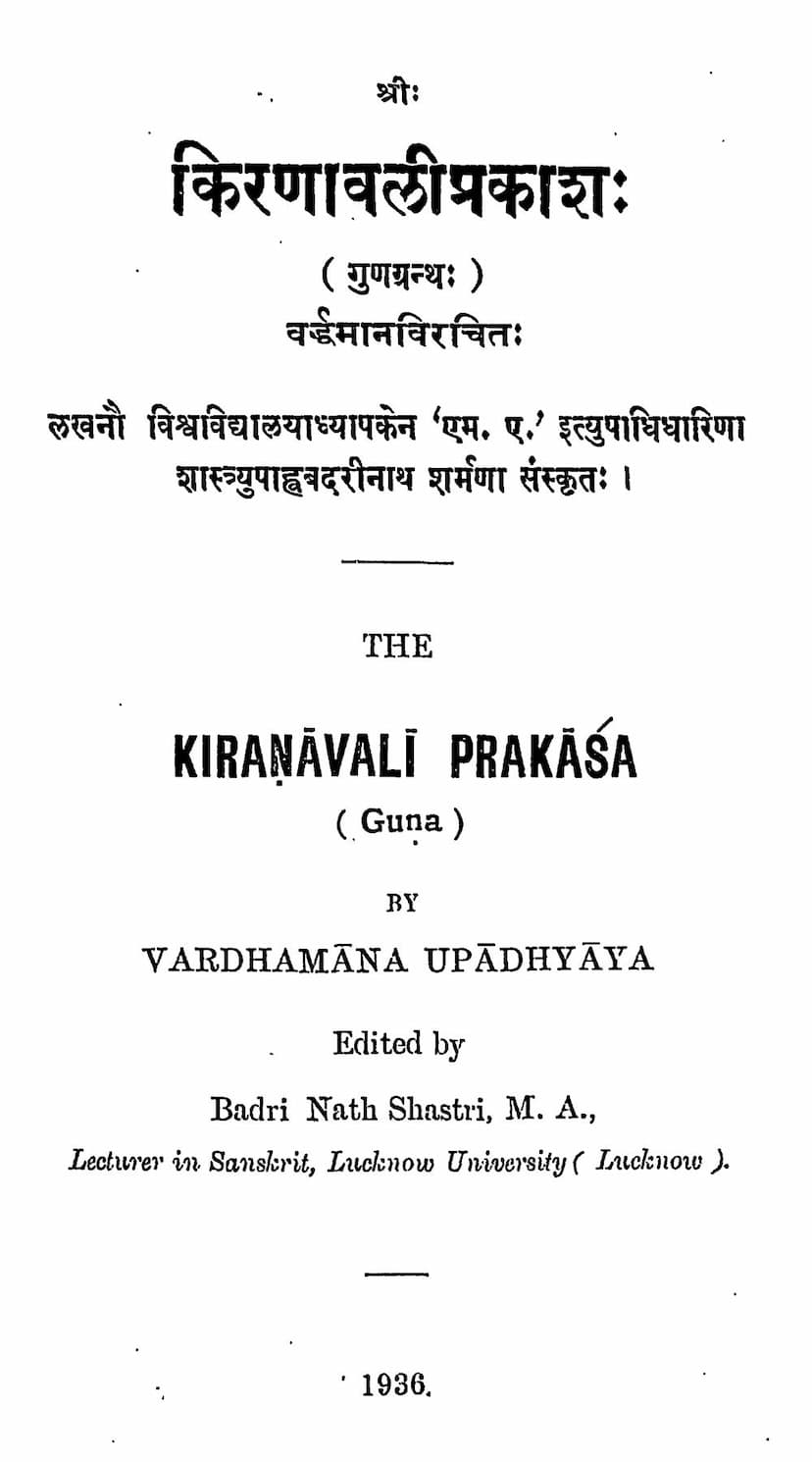Kinrnavali Prakash
Added to library: September 2, 2025

Summary
This document is a scholarly introduction and partial text of the Kiranaavali Prakash, a commentary on Udayana's Kiranaavali (specifically the Guna section). Here's a comprehensive summary based on the provided pages:
Book Title: Kiranaavali Prakash (गुणग्रन्थः) Original Author of Kiranaavali: Udayana Author of the Commentary (Kiranaavali Prakash): Vardhamana Upadhyaya Editor: Badrinath Shastri, M.A., Lecturer in Sanskrit, Lucknow University Publisher: Vardhamana Upadhyaya Badrinath Shastri Year of Publication: 1936
Introduction (Pages 3-4):
- Purpose of Publication: The introduction justifies the publication of Vardhamana's commentary on Udayana's Kiranaavali (Guna section). It emphasizes the importance of publishing all related late works to properly understand the Prasastapada Bhashya, a foundational text in the Vaisheshika system. The editor notes that other significant works in this tradition (Sūkti, Setu, Vyomavati, Nyāyakandali, Kiranaavali) have already been published.
- Author of the Commentary: Vardhamana Upadhyaya is introduced as the son of the renowned Gangeśa Upadhyaya, author of the Tattvachintamani. Vardhamana is considered a significant figure in the development of Neo-Logic in Bengal and Mithila.
- Vardhamana's Age: His exact age is not precisely known but is believed to be from the 14th century CE.
- Distinction from Other Vardhamanas: The introduction clarifies that this Vardhamana is distinct from an earlier author of the same name associated with Ganaratnamahodadhi (1140 AD) and also from a jurist named Vardhamana, son of Bhavesha, who authored Dandaviveka and Dharmapradipa.
- Vardhamana's Works: A list of Vardhamana's known works is provided, categorized by philosophical systems:
- Nyaya:
- Nyāyapariśiṣṭaprakāśa (commentary on Udayana's Nyāyapariśiṣṭa)
- Nyāyanibandhaprakāśa (commentary on Udayana's Nyāyavārtikatātparyapariśuddhi)
- Nyāyakusumāñjaliprakāśa (commentary on Udayana's Nyāyakusumāñjali)
- Tattvachintāmaņiprakāśa (commentary on his father's Tattvachintamani)
- Prameyatattvabodha
- Vaisheshika: 6. Kiranaavali Prakash (commentary on Udayana's Kiranaavali) 7. Nyayalīlāvatīprakāśa (commentary on Vallabha's Nyāyalīlāvati)
- Vedanta: 8. Khaņdanakhandakhādyaprakāśa (commentary on Sri Harsha's Khandanakhandakhādya)
- Nyaya:
- Significance of the Work: The introduction expresses the hope that this work will be invaluable for students of Indian philosophy, particularly Vaisheshika, aiding in the interpretation of complex passages in Udayana's text.
Textual Content (Pages 5-156 onwards):
The provided pages (5 onwards) contain the actual Sanskrit commentary by Vardhamana Upadhyaya, with the editor Badrinath Shastri's Sanskrit and English introduction. The text itself appears to be a detailed philosophical discussion, primarily focused on the Vaisheshika categories, particularly guna (qualities).
Based on the fragmented Sanskrit text, the commentary likely delves into:
- Causation and Division: Discussions about the causes of division (vibhāga) of substances, the role of different types of causes (e.g., non-inherent, instrumental), and the sequential process of division and destruction.
- The Nature of Perceptual Knowledge (Pratyaksha): Extensive analysis of perception, its causes, the role of sense-object contact (pratyāsaṃatti), and the distinction between determinate (savikalpaka) and indeterminate (nirvikalpaka) perception. There's a debate about whether knowledge itself is the object of perception or if it's an inferential process.
- The Concept of "Per" and "Apar" (Distance and Nearness): Detailed exploration of the Vaisheshika concepts of relative distance and nearness, their causes (time, space), and the role of relative judgment and perception.
- The Nature of Mind (Manas): Discussions about the mind as an internal sense organ, its causal role in cognition, and its independence or dependence on external senses.
- The Nature of Inference (Anumana): Analysis of the structure of inferential reasoning, including the role of the middle term (hetu), its properties (like vyapti, pakshadharmata), and various logical fallacies (hetvābhāsa).
- The Nature of Testimony (Shabda): Discussions about whether verbal testimony is an independent source of valid knowledge or can be subsumed under inference, and the role of authoritativeness (āptatva) and intention (tātparya) in understanding language.
- The Nature of Errors (Bhrama): Examination of misperception, its causes (e.g., defects, illusion), and the various theories of error, such as the theory of unintended reality (anyathākhyāti).
- The Vaisheshika Categories (Padarthas): The commentary likely explains the Vaisheshika categories like substance (dravya), quality (guna), action (karma), universal (sāmānya), particular (viśeṣa), inherence (samavāya), and absence (abhāva).
- Detailed Analysis of Specific Qualities: Based on the title and the mention of "Guna section," specific qualities like paratva and aparatva are discussed in detail, as well as potentially others related to sensory perception.
Overall Significance:
The Kiranaavali Prakash is presented as a crucial scholarly contribution to the understanding of the Vaisheshika system. By providing a detailed commentary on Udayana's influential work, Vardhamana Upadhyaya (through this publication) aims to clarify complex philosophical arguments, resolve interpretative difficulties, and make the Vaisheshika tradition more accessible to contemporary scholars. The editor's effort to publish this work in 1936 highlights the ongoing effort to preserve and disseminate important Indian philosophical texts.